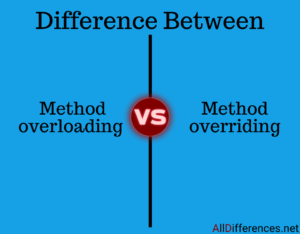Comparison between Method Overloading and Method Overriding
Contents
- Method overloading and method overriding are two important concepts in Java that are used to improve the readability and reusability of code.
- The key Difference Between Method Overloading and Method Overriding is that Method Overloading is a Compile time polymorphism. whereas Method Overriding is a Run time polymorphism.

Comparison Chart
- Here is a table that summarizes the key differences between Method Overloading and Method Overriding:
| Feature | Method Overloading | Method Overriding |
|---|---|---|
| Feature | A mechanism that allows a class to have multiple methods with the same name but different parameters. | A mechanism that allows a subclass to provide a different implementation for a method that is already defined in its superclass. |
| Compile-time polymorphism | Method overloading is a compile-time polymorphism. | Method overriding is a run-time polymorphism. |
| Inheritance | Not Required | Required |
| Parameters | Must be different | Must be the same |
| Return type | Can be the same or different | Must be the same |
| Access modifier | Can be more restrictive | Must be the same or less restrictive |
| Methods | Private and final methods can be overloaded. | Private and final methods can’t be overridden. |
| Example |
public void print(String message) public void print(String message, int number) |
public void add(int a, int b) public void add(int a, int b, int c) |
Overview of Method Overloading
Method overloading is a compile-time polymorphism technique that allows a class to have multiple methods with the same name, but with different parameters. The compiler determines which method to call based on the number and types of parameters that are passed to the method.
Example of method overloading
class MyClass {
public void print(int number) {
System.out.println(number);
}
public void print(String text) {
System.out.println(text);
}
}
Benefits of method overloading
Method overloading offers several benefits:
- It improves code readability by providing descriptive method names.
- It simplifies the API by consolidating related methods under a single name.
- It enhances flexibility by allowing different parameter types, enabling method reuse.
Overview of Method Overriding
Method overriding is a runtime polymorphism technique that allows a subclass to provide a different implementation for a method that is defined in its superclass. The Java Virtual Machine (JVM) determines which method to call based on the actual type of the object that is used to call the method.
Example of method overriding
class Animal {
public void makeSound() {
System.out.println("Generic animal sound");
}
}
class Dog extends Animal {
@Override
public void makeSound() {
System.out.println("Woof!");
}
}
Benefits of method overriding
Method overriding offers several advantages:
- It enables customization and specialization of inherited methods in subclasses.
- It promotes code extensibility by allowing subclasses to modify behavior without modifying the superclass.
- It supports polymorphism, allowing objects of different subclasses to be treated uniformly through a common interface.
Conclusion
In Java, method overloading and method overriding are powerful techniques that enhance code flexibility, reusability, and polymorphism. While both concepts involve the creation of multiple methods with the same name, they differ in their purpose and context.
Method overloading allows for the creation of multiple methods with different parameter types or numbers, improving code readability and offering flexibility. On the other hand, method overriding enables subclasses to provide their own implementation of inherited methods, allowing for specialization and customization.
Understanding the differences between method overloading and method overriding is crucial for Java developers, as it enables them to leverage these features effectively and design robust and extensible code.
FAQs
- What happens if a method is overloaded but not overridden? When a method is overloaded but not overridden, each method with a different signature will be treated as a separate method within the class. Overloading does not affect the behavior of methods in subclasses.
- Can method overloading and overriding be used together? Yes, method overloading and overriding can be used together. Overloading can be applied within a class, while overriding is specific to subclassing. Both techniques contribute to code flexibility and extensibility.
- Are method overloading and overriding limited to Java? No, method overloading and overriding are common features in object-oriented programming languages. While the syntax and rules may differ, the underlying concepts exist in languages like C++, C#, and Python.
- What are the advantages of using method overloading? Method overloading improves code readability, simplifies the API, and enhances flexibility. It allows you to create variations of a method based on different parameter types or numbers, enabling method reuse and reducing code duplication.
- How does method overriding contribute to code reusability? Method overriding supports code reusability by allowing subclasses to inherit and modify the behavior of methods from their superclass. It promotes the principle of polymorphism, where objects of different subclasses can be treated uniformly through a common interface.
